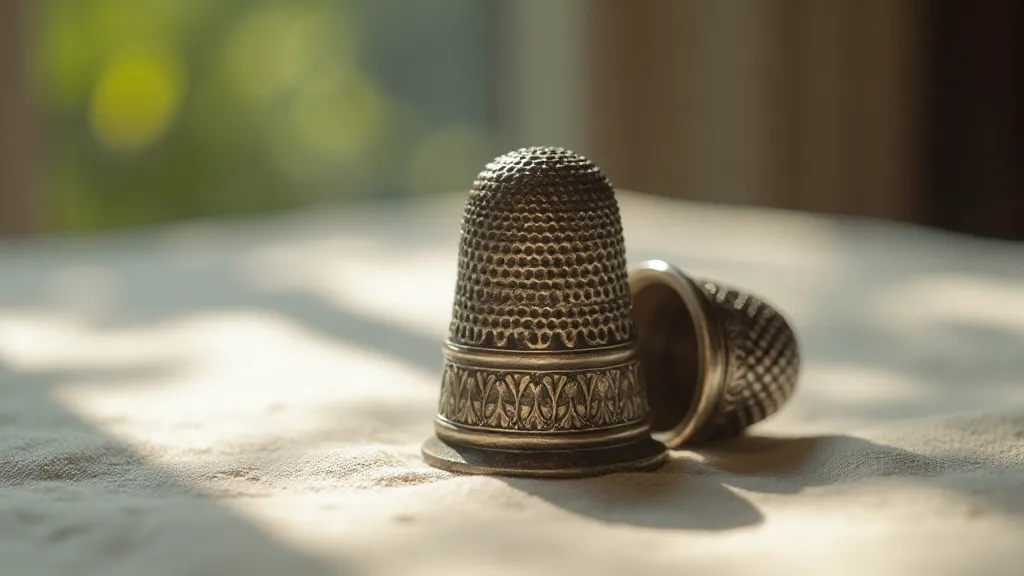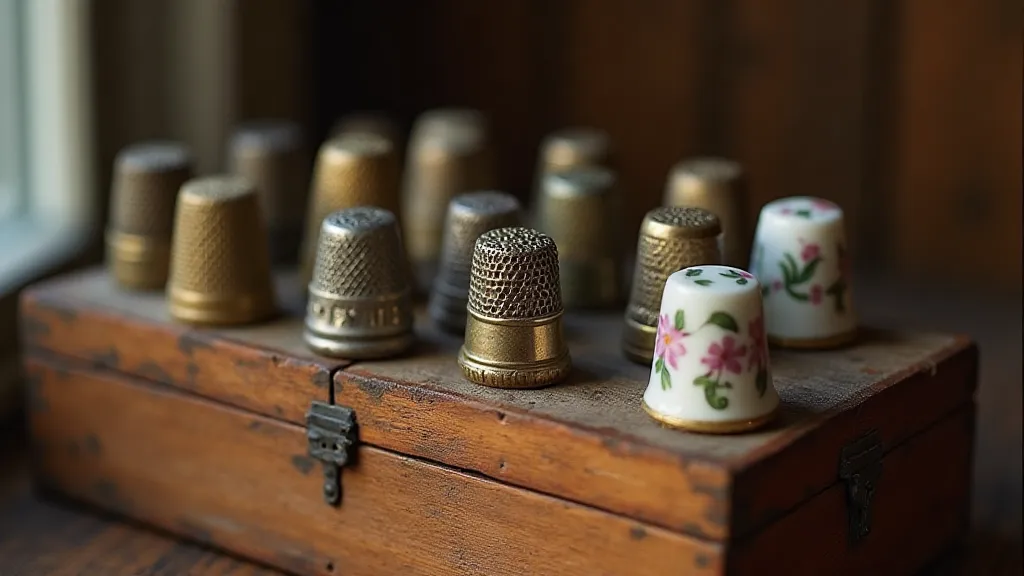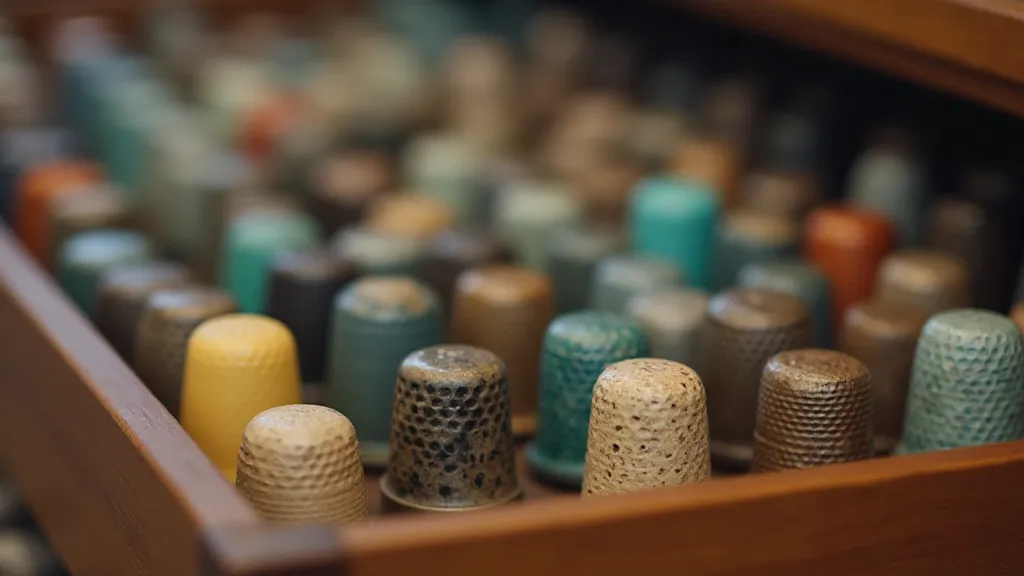A Pocketful of Memories: The Thimble’s Role in Migration and Storytelling
The simple thimble. A tiny guardian of fingertips, a humble tool in the art of sewing. We often think of it as a utilitarian object, something practical and readily replaceable. But look closer. Really look. For those who understand their history, a vintage thimble isn’t merely metal; it’s a silent witness, a portable heirloom, a vessel brimming with stories passed down through generations, often carried across oceans and continents.
My grandmother, Elsie, kept a small collection of thimbles nestled in a velvet pouch. They weren't displayed prominently; they were tucked away, a private treasure. As a child, I would beg her to let me see them. Each one was different—silver, brass, painted porcelain—and she’s tell me a little about each, usually a fragment of a memory. One, a heavily tarnished silver thimble, she claimed belonged to her great-grandmother, Anna, who had emigrated from Ireland in the late 1800s. Anna, she’s recounted, had sewn clothes for her entire family, and the thimble represented resilience, ingenuity, and the unwavering spirit of survival in a new land.

The Thimble's Journey: A Portable Heritage
The history of the thimble stretches back centuries. While basic finger protection existed earlier, the standardized, metal thimble as we know it began to appear in Europe during the 16th century. Mass production in the 19th century made them affordable and accessible, but their portability cemented their role as travel companions. As people migrated – fleeing famine, seeking opportunity, or escaping persecution – these small objects often went with them, tucked into pockets, wrapped in fabric, or carefully packed alongside treasured belongings.
Consider the waves of European immigrants who flocked to America in the 19th and early 20th centuries. Many arrived with nothing but the clothes on their backs and the skills they possessed. Sewing, of course, was an essential skill for women – for mending clothes, creating necessities, and even earning a meager income. The thimble, a tiny symbol of their craft and their connection to home, became a poignant reminder of everything they had left behind. Imagine a young woman, leaving behind her family in Germany, clutching a simple pewter thimble her mother had given her – a tangible link to her past, a source of comfort in a foreign land. The evolution of these objects, and the intricate ways artisans approached their craft, is a story in itself. The history of embellishment – the subtle variations in design and decoration – often mirrors broader cultural shifts; to truly appreciate a vintage thimble is to begin to understand the language of embellishment itself.
The patterns on antique thimbles themselves often whisper stories. German thimbles frequently displayed intricate floral motifs, reflecting the country’s reputation for craftsmanship and connection to nature. English thimbles often featured heraldic symbols, representing family history or local pride. French thimbles, known for their elegance, often bore decorative engravings or were made of precious metals. Recognizing these motifs can offer subtle clues about the thimble’s origin and the potential story it carries.
Craftsmanship and Materials: Decoding the Stories
The materials used to create antique thimbles also tell a tale. Early thimbles were often made of leather or bone, but the advent of metalworking led to the widespread use of brass, silver, and eventually, steel. Silver thimbles, particularly those intricately decorated, often belonged to wealthier families, signifying a level of comfort and social standing. Brass thimbles were more common, representing the workhorse of the sewing room – reliable, durable, and widely accessible. The artistry involved in transforming base metals into these enduring objects is truly remarkable. In fact, the process of taking relatively simple components and crafting them into heirloom treasures is a subject worthy of deeper exploration; you can learn more about the alchemy of stitch and the artistry behind it.
Look closely at the markings. Some thimbles bear maker’s marks, providing valuable information about their origin and date. Hallmarks on silver thimbles are particularly helpful in identifying their age and the silver content. Even the wear patterns – the smoothed edges, the worn surfaces – can tell a story of countless hours spent protecting fingertips and shaping fabric. Beyond the metals themselves, the evolution of the crafting process is intertwined with the wider world of textiles. The styles and trends found in thimble design frequently reflect changes within the broader textile landscape. Exploring a tapestry of time reveals the beautiful correlation between thimble design and the broader world of textiles.

Beyond Utility: Sentiment and Connection
Perhaps the most compelling aspect of antique thimbles is their ability to evoke powerful emotions. They are not just tools; they are conduits to the past. They connect us to the hands that crafted them, the lives they protected, and the stories they carried. A child finding a thimble tucked away in a grandmother's attic may feel a sudden and inexplicable connection to a past they never knew.
My grandmother, Elsie, never explicitly explained the significance of her thimble collection. She simply let me handle them, encouraging me to imagine the hands that had held them before. It was in those quiet moments of connection that I began to understand the deeper meaning of these tiny objects – a tangible link to my family history, a reminder of the strength and resilience of those who came before me.
The practice of collecting vintage thimbles isn’t just about acquiring objects; it's about preserving memories, honoring traditions, and understanding the human experience across generations. Each thimble holds a potential story, waiting to be uncovered, pieced together, and shared.
Sometimes, a thimble is found in unexpected places – in an old trunk, nestled amongst yellowed letters, or discovered during renovations. These finds often spark curiosity and a desire to learn more about the lives of those who once held them. It’s like receiving a tiny, silent message from the past, inviting us to delve deeper into our family history and appreciate the enduring power of human connection.

The Significance of Precious Stones and Design
While the vast majority of thimbles were functional objects designed for everyday use, some artisans elevated their craft to an art form. The inclusion of precious stones, intricate engraving, and elaborate detailing transformed the humble thimble into a miniature masterpiece. These embellishments were often indicators of wealth and status, reflecting the discerning tastes of the thimble’s owner. These stunning creations often utilized advanced techniques and materials, showcasing the ingenuity and skill of the artisan. The addition of jewels to a thimble was not merely decorative; it signified something deeper, a symbol of prestige and refinement. Understanding the story behind these treasured heirlooms can be fascinating, much like exploring the details that give certain collections their special value – a concept explored further in Beyond the Material: Understanding the Intangible Value of Heirloom Thimbles.
Caring for Your Vintage Thimble
Preserving these precious artifacts requires careful consideration. While cleaning is important for removing surface grime and revealing the thimble’s true beauty, aggressive methods can cause irreparable damage. Gentle cleaning with a soft cloth is generally recommended. Avoid harsh chemicals or abrasive cleaners, as these can damage the delicate metal or painted surfaces. Proper storage – in a clean, dry place – is essential for preserving their condition for future generations. Consider using archival-quality boxes or pouches to protect your thimbles from dust, light, and moisture.
Further Exploration
The world of antique thimbles is vast and fascinating. From the history of their creation to the stories they hold, these tiny objects offer a window into the past. Whether you are a seasoned collector or simply curious about these charming relics, there is always more to discover.





